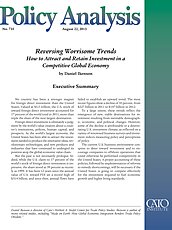No country has been a stronger magnet for foreign direct investment than the United States. Valued at $3.5 trillion, the U.S. stock of inward foreign direct investment accounted for 17 percent of the world total in 2011, more than triple the share of the next largest destination.
Foreign direct investment is ultimately a judgment by the world’s value creators about a country’s institutions, policies, human capital, and prospects. As the world’s largest economy, the United States has been able to attract the investment needed to produce the innovative ideas, revolutionary technologies, and new products and industries that have continued to undergird its position atop the global economic value chain.
But the past is not necessarily prologue. Indeed, while the U.S. claim to 17 percent of the world’s stock of foreign direct investment is impressive, the share stood at 39 percent as recently as 1999. It has been 12 years since the annual value of U.S. inward FDI set a record high of $314 billion, and since then, annual flows have failed to establish an upward trend. The most recent figures show a decline of 35 percent, from $227 billion in 2011 to $147 billion in 2012.
To a large extent, these trends reflect the emergence of new, viable destinations for investment resulting from inevitable demographic, economic, and political changes. However, some of the decline is attributable to a deteriorating U.S. investment climate, as reflected on a variety of renowned business surveys and investment indices measuring policy and perceptions of policy.
The current U.S. business environment conspires to deter inward investment and to encourage companies to offshore operations that could otherwise be performed competitively in the United States. A proper accounting of these policies, followed by implementation of reforms to remedy shortcomings, will be necessary if the United States is going to compete effectively for the investment required to fuel economic growth and higher living standards.

